 Leading Blog | Posts by Month |
 Leading Blog | Posts by Month |
09.30.19

LeadershipNow 140: September 2019 Compilation
See more on
Posted by Michael McKinney at 07:41 AM
09.26.19

How Your Bright Shiny Objects Derail Your Team — and Damage the Business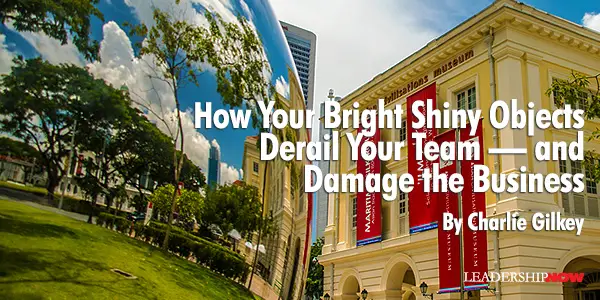
IN COACHING VISIONARY LEADERS, I hear a common pain point: Their team isn’t moving fast enough or focusing on the right things. As we dig deeper, however, we inevitably discover that their team isn’t the problem. Instead, it’s their own preoccupation with bright shiny objects — or what I call BSOs. From madcap product ideas to mythic mergers, BSOs can run the gamut. All the same, they’re a challenge for visionary leaders. No doubt, their ability to bridge the gap between unlimited possibility and reality is a critical skill. But, when left unchecked, their attraction to BSOs often hurts their teams, usually by derailing their work with needless obstacles. Even more critically, BSOs have the propensity to damage the business. How? By introducing ideas that should have never been considered in the first place. After all, just because something could be done doesn’t mean it should be done. If you’re a visionary leader, and can admit to loving BSOs, you most likely need a process to better understand, manage, and vet them. Ask yourself questions Imagine a typical Monday morning huddle. Your team is busy discussing current or upcoming projects and priorities. Then, with unbridled exuberance, you storm in and say, “I’ve got an amazing idea.” Unbeknownst to you, it’s like you just lobbed a bomb onto the team. Now, to indulge your BSO, they lose their energy and focus. So how can you tell when you’ve just lobbed a BSO onto your team? Stunned silence. Rolling eyes. Icy stares. Crossed arms. A barrage of questions. Those are only some of the signs. Plus, under their breath, people are probably muttering some kind of rebuke. “Are you kidding me?” “Oh, come on. Seriously?” “Here we go again.” “But what about…?” Et cetera. To avoid such an experience — let alone not derail your team — make a habit of first asking yourself a few questions about your current BSO. Consider these five to start: 1. How does this align with the business’s current strategies and priorities? 2. How would doing this affect other, more important work? 3. What business concerns would this solve, and do we already have other, potentially better solutions in place? 4. If this is actually something we should do, what is the best timing — to do it now or to wait until some other business priorities have been met? 5. Who can I run this by before lobbing it onto my team? Enlist a “voice of no” At some point, most visionary leaders learn that they need a COO or other common-sense leader to counterbalance their BSOs. I call such a person a “voice of no.” So, when a visionary leader brings up a BSO, her voice of no might say, “Here’s why we can’t do that right now” or “Here’s what must happen first.” In this way, a voice of no protects a leader’s team from creative mayhem while also not stifling the leader’s visionary proclivities. In considering a COO or a voice of no, look for someone who clearly gets the importance of focus, continuity, and business priorities, and who seems to have a “less is more” mindset — preferring to do fewer things very well than to do many things ineffectively. If you’re not in a position to bring in a COO or a voice of no, you can develop your team to take on the role. This, however, will require you to openly acknowledge your BSO inclinations, to have clear-cut business imperatives, to give people the authority and freedom to ‘gut check’ your ideas, and to make room in meetings for real, strategic conversations. Have a vetting process It took me years to recognize my own insatiable appetite for BSOs. The good news is I now have a simple process in place to properly vet my BSOs and, in doing so, to protect my team from any “incoming.” To start vetting your own BSOs, I suggest these four steps: 1. Find a sounding board. Seek out someone thoughtful and measured, inside or outside the business but not on your team, to serve as your sounding board. Look for someone who you can trust and feel comfortable with to casually bounce around ideas and, equally important, who is fully capable of being candid with you. For me, that’s my business partner and wife, Angela, who also acts as my voice of no. If she isn’t convinced, I know to let go of a BSO or at least put it on ice. 2. Put your idea in writing. If your idea seems workable after bouncing it off your sounding board, put it in writing. This needn’t be pretty or take up much time. Just create a skeleton with your rough thoughts and some preliminary goals. The point here is to simply flesh out your idea enough to be easily articulated and understood. 3. Seek first-round feedback. Once you’ve put your idea in writing, go back to your sounding board and one or two other people (but, again, no one on your team). Ask for feedback, both positive and negative, on your thought process and on the clarity and viability of your idea. Take this input to heart and then create a tighter, slightly more formal document. 4. Approach your team. At this point, your idea has gone from being a BSO to something much more tangible and well thought out. So, finally, it’s time to go ahead and bring the idea to your team. I suggest giving them a few days or even a week to read and mull everything over, and also scheduling a meeting to discuss their feedback and, if appropriate, consider the way forward. Also, be sure to remind people that they have the authority and freedom to push back on your idea and even act as a voice of no. And last but not least, remember that your team is only as effective and successful as your leadership. By learning to understand, manage, and vet your BSOs, you’ll help your team to move fast — and focus on the right things.  
Posted by Michael McKinney at 12:12 AM
09.24.19

“That Will Never Work”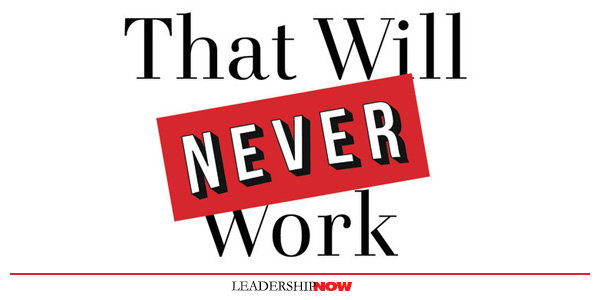
THE STORY GOES that the idea for Netflix came to Reed Hastings after he was hit with a $40 late fee when he returned his rental of Apollo 13 to Blockbuster. Annoyed, he thought, “What if there were no late fees?” And wham, the idea for Netflix was born. Of course, we like stories like that. It’s neat and clean, but in this case, it’s not true. It’s useful though, and it captures in a paragraph the essence of what Netflix is all about. Marc Randolph, Netflix’s co-founder, and first CEO says it’s emotionally true. “Reed’s oft-repeated origin story,” he says, “is branding at its finest, and I don’t begrudge him for it at all.” The real story is longer. While it is messy and complicated, it is much more exciting. Marc Randolph shares it all in That Will Never Work: The Birth of Netflix and the Amazing Life of an Idea. I read a lot of business books, and I can say this is one of the best you’ll ever read on starting and growing a business—the emotions, the triumphs, the failures and the lessons learned. The story is a well-told page-turner. Briefly, the real story is that while carpooling with Hastings to jobs that would soon be redundant due to a merger, Randolph would pitch ideas to him in search of the next act. After a slew of ideas like customized shampoo, dog food, and baseball bats, Randolph hit upon renting VHS tapes online. But, among other things, the costs for acquisition and shipping were too high, so it was ruled out. That is until they learned about an emerging technology—DVDs. Then the game was on. DVDs were cheaper and lighter, but would they be shipped safely. They tested it by mailing a CD in a greeting card envelope to Hastings. It worked, and they had their idea. And people said, “That will never work.” When you start a company, what you’re really doing is getting other people to latch on to an idea. You have to convince your future employees, investors, business partners, and board members that your idea is worth spending money, reputation, and time on. Randolph risked his time and Hastings risked his money. Now the work began. I needed to come up with something approaching a business plan. Notice that I used the word “approaching.” I never intended to get there. Most business plans are a complete waste of time. They become obsolete the minute the business starts and you realize how wildly off the mark you were with your expectations. So the trick is to take your idea and set it on a collision course with reality as soon as possible. Randolph takes us through the whole process from idea to launch day. Any entrepreneur will relate to the journey, and any would-be entrepreneur will find it enlightening. He candidly writes about pitching the idea to investors (what it was like to take a check for 1.9 million dollars to the bank), finding and getting talent, setting up an office, building the basics, building an inventory and the mailer, and building a website. And creating an innovative culture: Real innovation comes not from top-down pronouncements and narrowly defined tasks. It comes from hiring innovators focused on the big picture who can orient themselves within a problem and solve it without having their hand held the whole time. We call it loosely coupled but tightly aligned. He adds this: Most companies end up building a system to protect themselves from people who lack judgment. And that only ends up frustrating the people who have it. Launch Day: April 14, 1998 There are a great many stages in the life cycle of a startup. But a tectonic shift happens on launch day. Before you go live, you’re in the dreamy zone of planning and forecasts: your efforts are provisional. For better and for worse, things never go as planned. And Randolph gives an account of all of it—the possible acquisition of Netflix by Amazon, the potential buyout by Blockbuster, the rethinking of the business model, the ups and downs. Great stories with lessons in them all. My favorite chapter was, I’m Losing Faith in You. After about 18 months in, Hastings comes to him and tells him that he’s losing faith in his ability to run the company alone. He suggests (really more of an ultimatum) that he come in as CEO and Randolph become president. He writes, “Radical honesty is great, until it’s aimed at you.” Randolph had to take a look at himself—his strengths and weaknesses, his goals and motivations—and decide what was best for the company. It takes a tremendous amount of humility to do that and to agree to what Hastings was asking. I realized that there were really two dreams, and I might need to sacrifice one of them to ensure that the other came true. And that was Hastings strength. Hastings became CEO and Randolph became the president in 1998. His self-knowledge made is easier for him to know when it was time to go as he eventually did in 2003 not long after Netflix went public. He realized that he liked building things more than the finished product. In the end he writes, “I missed the late nights and early mornings, the lawn chairs and card tables. I missed the feeling of all hands on deck, and the expectation that every day you’d be working on a problem that wasn’t strictly tied to your job description.” 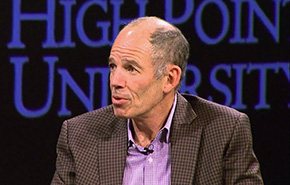 Randolph is conversational and generous to others throughout. There is a lot of experience-based wisdom in this book. Here are a few more insights: We were always trying to avoid one of the number one pitfalls of startup entrepreneurship: building imaginary castles in your mind, meticulously designed, complete with turrets, drawbridges, moats. Overplanning and overdesigning is often just overthinking—or just plain old procrastination. When it comes to ideas, it’s more efficient to test ten bad ones than spend days trying to come up with something perfect. 
Posted by Michael McKinney at 04:35 PM
09.18.19

Looking for Ways to Improve Innovation? Improvisational Comedy Can Show You How
DISRUPTION is happening in even the most stalwart industries, leading business leaders scrambling to create a culture of innovation in their organizations. Coming up with amazingly novel ideas isn’t an innate ability but can be a learned skill that leaders and their teams can develop. The techniques of improvisational comedy can provide important lessons for developing a innovation mindset. From my 20 years of performing, directing, and producing live improvisational comedy, I’ve learned that fresh ideas are out there for the picking. Originality and innovation blossom from deep in the recesses of the mind, not because some people have the magical creative gene, but because they open themselves up to recognizing and exploring the uncharted areas in everyday work and life. This is where improvisational actors excel and why improv comedy techniques can lend themselves to promoting an innovation culture within organizations. Here are some methods honed through improv that can trigger new and expansive ideas: 1. Steer clear of the word “No.” In improv, actors are taught to avoid saying No. If an improv actor offers an idea and the scene partner replies No to it, then the scene is effectively over. Improvisational actors are trained to use the words “Yes, and…” to quickly move ideas forward and create completely new and unexpected concepts. Using “Yes, and” works best while your team is in the ideation phase. As you get to the execution phase, you may need to start saying No and eliminating concepts with little chance of working. But by listening and encouraging the team to offer ideas in the initial stages, team members will feel included and be more inclined to have buy-in on a final decision. 2. Perfect the practice of “heightening.” Heightening is a way to allow concepts to evolve in ways that allow them to grow from a seemingly normal, practical idea into a wild, unconventional end product. In improv comedy, the actors step out on the stage not knowing what they’re going to do or say, or what their fellow actors are going to do or say. Without any planning, they take the rawest of material and weave a tale with multiple layers, different characters, random jumps in time and unexpected twists and turns -- all somehow leading to a neat resolution. This is “heightening,” and it allows their imaginations to go to exciting and original places, unfettered by practicality or reality. When teams allow heightening to take, they generate far more material to consider. The original idea is still there and you can go back to it at any point, but you may also find that by letting imaginations run free, you’ll have new, exciting and more interesting versions of the original concept. 3. Expand your curiosity. Make a point to follow where your curiosity leads you. Interested in bird watching? Sign up for an outing where you’ll meet people who can share their knowledge about types of gear, bird species, and even what’s threatening bird habitat. Pursuing new interests can’t help but have a ripple effect. The unexpected benefit that comes from putting new pursuits into motion is that you discover all the different offshoots that surround an activity. Simply by expanding your knowledge, you have a means of uncovering fascinating raw material to turn into new ideas. You’ll begin to see connections or possibilities in all kinds of unexpected places. Those unexpected connections are what lead to innovation. 4. Brush off the shame from being wrong. The fear of being wrong is one of the biggest reasons we don’t put our ideas forward. The way you build your tolerance to feeling shame from a failure is by repeated exposure. Working as a comedian has helped me build up my resiliency. By failing a whole bunch of times in low-stakes environments -- on open mic stages in crappy bars and clubs -- I began to develop scar tissue. And when I failed, I dissected what worked and what didn’t so I could improve the next time. Being willing to strike out into the unknown and face the chance of failing or being wrong becomes easier each time you do it. Also, acknowledging you were wrong about a decision or idea can open you up to being right. You learn something new from being wrong and, oftentimes, better options appear. Failing allows things to become clear, and you begin to understand what you may not have realized before. Allowing yourself and your team to become unfettered in idea creation, to open up to outlandish ideas, to be unselfconsciously curious, and to overcome fear of failure. If you do this, you and others on your team will start to experience the feeling of inspiration finding you instead of you finding it.  
Posted by Michael McKinney at 06:18 PM
09.16.19

How to Humanize Leadership
Plant this seed within your core
Humanizing Leadership Mentors During the book writing process, I reflected on the multitude of individuals who graciously shared their time, words, wisdom, and encouragement with me along my personal leadership journey. Often, these individuals had confidence in me before I had confidence in my own ability. They provided me with the essential space and pivotal opportunities to learn, experiment, fail, and grow. They created a workplace environment in which my contributions mattered and in every human interaction with me demonstrated this. How they showed up as leaders and how they engaged was critical to my leadership development. What was common in these leaders was first and foremost they were human beings and meaning makers. They understood that organizational systems are made up of many dynamic and emergent human systems. Through their actions they provided a higher purpose, empathy, and shared meaning all critical foundations for people and organizational development. Humanizing Leadership Overcomes Outdated Organizational Views Humanizing leadership is about overcoming an outdated organizational view that taught us to define oneself and value to our organization by the closed and often fragmented black boxes on the organizational chart. Humanizing leadership is about embracing the white space between the boxes, imbuing it with deeper meaning and purpose. The “organizational chart map” is essentially an aggregate of isolated power blocks with a steep hierarchy command center. The blank white space is the real organization; it’s a place where personal relationships and loyalties exist. It is also an organizational space where top-down driven interactions often produce misattribution including misunderstood and misinterpreted information. Humanizing Leadership Is Awakened Through Three Truths Humanizing Leadership is about awakening to and harnessing three powerful leadership truths: reflection fuels, people matter, and relationships make the difference. These three consequential realities have a profound impact on our ability to lead effectively and help regulate the well-being and strength of the organizations we serve. By understanding the human paradox of simultaneous continuity and change, ambiguity, and complexity, humanizing leadership develops the personality and conceptual skills for successful juxtaposition of opposites to find the sweet spot. Through forty-two leadership vignettes, the book Humanizing Leadership will change the way you look at leadership and at yourself. It strives to hold a mirror up to your beliefs about who you are, and leadership in general by putting a human face on leadership. These three threads are used to weave a tapestry of self-discovery and personal humanizing leadership growth. 1. Reflection Fuels. As leaders, we operate within a web of people relationship systems, and the health and power of these relationships are dependent upon the level of trust we carry within ourselves. We cannot expect to harness the full potential of our organizations, and relationships within them, if we fail to fully understand our behavior and the impact our behavior has on those who bring visions and goals to fruition. We are not above the organizations we lead; we are a part of them. The practice of self-awareness and self-reflection for those in leadership roles extends back thousands of years to the ancient philosophers and teachers. Yet nowadays, it seems self-reflection is often a leader’s least favorite pastime or a component of leadership that is sacrificed for some other facet of leadership. In order to improve our leadership expertise, we must become aware of our strengths and weaknesses, our values and behaviors, and the ways in which they attempt to influence others. Our relationships with others mirror the relationship we have with self; a de-humanizing leadership behavior gives others permission to act in a similar vein. 2. People Matter. We need to continuously ask ourselves whether we are treating and interacting with people like they matter. Too often, a “people matter” concept within an organizations value statement is limited to the words printed on a piece of paper. It is not enough to merely recognize the role and significance people have within our organizations, we must commit and establish a direction to alter organizational “people matter” mindsets. To make the people an asset metaphor a reality, leaders must be inclusive. When we actually carry out a “people matter” approach our organizations benefit, and we as leaders benefit. A fully engaged workforce will outperform a disengaged workforce any day of the week. There are numerous research studies that back this assertion. Moreover, employees who are engaged in the workplace are more open to innovative ideas and new tools. They are open to new ways to enhance the work they do, rather than just performing the bare minimum required. This attitude is a prerequisite for innovation and growth. 3. Relationships Make the Difference. Humanizing leadership creates the glue that holds the fabric of a human system together, and the elasticity, bond, and effectiveness of the glue is determined by the overall relationship welfare of the organization. Organizations do not exist of fragmented parts, but rather a series of human systems within a larger and connected human system. We are aware that structure follows strategy and function follows form, but relationships run the show. Without relationships, there is no strategy implementation, and there is no function, to begin with. What goes on between people; employees, customers, suppliers, financiers, management, the board, etc. defines what an organization is and what it can become. It also defines the quality of humanizing leadership. Humanizing Leadership Is About Choice The book requires reader participation. The weight of the message is within the reader, not on the pages. The words and ideas shared are personal experiences and understandings that are open to adaptation. The reader is asked to use the personal insights and the provocative questions posed as a springboard for self-discovery. The Chinese philosopher Lao Tao said, “When I let go of what I am, I become what I might be.” Letting go creates the space for relationships and a collective identity to develop, for information to be shared, and for the talents of everyone within human organizational systems to be valued. On the strength of these behavioral and mindset shifts, we can achieve the collective accountability required for making organizational improvements. Ask this key question; what behavior have I tolerated in myself or in others that conflict with people matter and relationships make the difference? It’s about choice. “It is not the truth that we do not know that does us in,  
Posted by Michael McKinney at 12:13 AM
09.13.19

The 10 Stories Great Leaders Need to Tell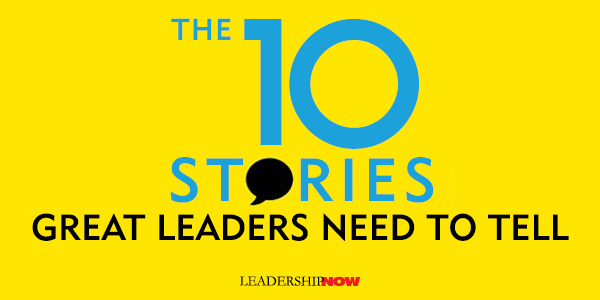
WE KNOW GREAT STORIES are the foundation of great communication. It’s not the idea but the story about the idea that begets followers. The question is, are you telling the right story? A leading expert in organizational storytelling, Paul Smith advises us that more important than how we tell a story is what story we are telling. And by story, he means “a narrative about something that happened to someone.” As such, it will include a time, a place, and a main character. That main character will have a goal, and there will probably be an obstacle getting in the way of that goal—a villain, if you will. And there will be events that transpire along the way that hopefully resolve themselves in the end. On the pages of The 10 Stories Great Leaders Tell—a book designed to be read in about an hour—Paul Smith reveals the ten most important stories a leader needs to tell and how to begin to craft our own unique story. Each story has a specific objective. These stories tell us why. The first four stories are about setting the direction for the organization: Story 1: Where We Came From (A Founding Story)
Story 2: Why We Can’t Stay Here (A Case-for-Change Story)
Story 3: Where We’re Going (A Vision Story)
Story 4: How We’re Going to Get There (A Strategy Story)
The next four stories are about who we are as an organization: Story 5: What We Believe (A Corporate-Values Story)
Story 6: Who We Serve (A Customer Story)
Story 7: What We Do for Our Customers (A Sales Story)
Story 8: How We’re Different from Our Competitors (A Marketing Story)
The last two are about you as a leader: Story 9: Why I Lead the Way I Do (A Leadership-Philosophy Story)
Story 10: Why You Should Want to Work Here (A Recruiting Story)
Smith has also produced a workbook to accompany this book to help you begin to tell the stories you need to be telling. Good examples accompany each of the ten stories. In conclusion, Smith offers an outline in the form of eight questions to help you to organize and structure the ideas and stories you have collected. Equipped with stories like these, you will become a more effective leader. 
Posted by Michael McKinney at 12:44 AM
09.11.19

No Better Friend, No Worse Enemy.
AFTER THE TERRORIST ATTACKS on September 11, 2001 and on the eve of the 2003 invasion of Iraq, Major General James Mattis needed to connect with every member of the 1st Marine Division. He writes, “I limited myself to one page they could carry with them, a message reconciling ferocity toward the foe with abiding concern for the innocents caught on the battlefield.” A letter like this serves to encourage, but it also provides what Mattis calls “commander’s intent.” Marines are aggressive, have a bias for action, and are trusted to act within the commander’s intent. In other words, they are given direction and not a lot of instructions. Here’s what we want to accomplish and why. Here’s what we don’t want to do, and why.” It provides context to the action, explicit boundaries, and the trust to act and improvise in any way necessary within those boundaries to achieve the desired result. This is easily applied to any team. This model of leadership encourages initiative and brings out individual talents, and more importantly, it demonstrates trust. It is one thing to say you trust your team. It is quite another thing to show them that you do. He signs off with a phrase he made the motto of 1st Marines: "No Better Friend, No Worse Enemy." It was adapted from a remark attributed to the Roman general Lucius Cornelius Sulla, “No friend ever served me, and no enemy ever wronged me whom I have not repaid in full.” His letter to the Blue Diamond: MARCH 2003 1st Marine Division (REIN)
For decades, Saddam Hussein has tortured, imprisoned, raped and murdered the Iraqi people; invaded neighboring countries without provocation; and threatened the world with weapons of mass destruction. The time has come to end his reign of terror. On your young shoulders rest the hopes of mankind. When I give you the word, together we will cross the Line of Departure, close with those forces that choose to fight, and destroy them. Our fight is not with the Iraqi people, nor is it with members of the Iraqi army who choose to surrender. While we will move swiftly and aggressively against those who resist, we will treat all others with decency, demonstrating chivalry and soldierly compassion for people who have endured a lifetime under Saddam's oppression. Chemical attack, treachery, and use of the innocent as human shields can be expected, as can other unethical tactics. Take it all in stride. Be the hunter, not the hunted: never allow your unit to be caught with its guard down. Use good judgement and act in best interests of our Nation. You are part of the world's most feared and trusted force. Engage your brain before you engage your weapon. Share your courage with each other as we enter the uncertain terrain north of the Line of Departure. Keep faith in your comrades on your left and right and Marine Air overhead. Fight with a happy heart and strong spirit. For the mission's sake, our country's sake, and the sake of the men who carried the Division's colors in past battles—who fought for life and never lost their nerve—carry out your mission and keep your honor clean. Demonstrate to the world there is "No Better Friend, No Worse Enemy" than a U.S. Marine. J. N. Mattis
In Call Sign Chaos, he recalls that he learned a lot from the British officers at that time. “I adapted their approach of showing no triumphalism—we had come to liberate, not dominate. We did not push our way around.”

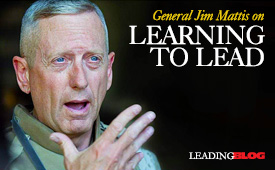 
Posted by Michael McKinney at 08:12 PM
09.09.19

Learning to Lead with Ron Williams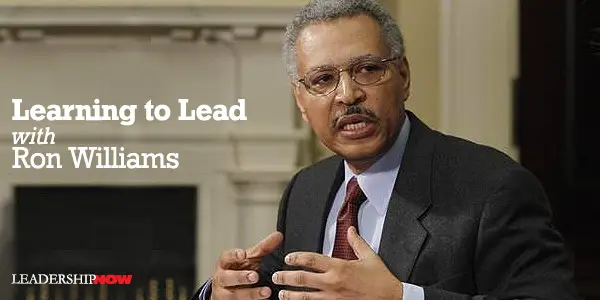
WHO IS looking out for you? “No boss or mentor drove my success—although they did open doors for me. My success came about through a combination of hard work, continual learning, fortunate career choices, and a bit of luck—by being in the right place at the right time,” writes Ron Williams. Williams is best known for his tenure as CEO and Chairman of Aetna, where he transformed a $292 million operating loss into $2 billion in annual earnings. In Learning to Lead, Williams shows how anyone can grow and succeed as leaders. He grew up in a working-class family in one of the poorest neighborhoods of Chicago in the 1960s. The book is exceptional. He weaves the experiences of his career with the lessons we can all learn from them. Well told and insightful. He begins by asserting that the single most important asset you have is you. As a result, you need to focus on getting better. “Two things are essential: a deep personal commitment to excellence in everything you do and a commitment to continual improvement.” He encourages us to strive to become 15% better each year in concrete and actionable ways. To do that you need to really think about what you are going to do differently. If you want to be extraordinary, you need to stretch yourself above the average person. Exceed your job description. Do it for you and build a reputation. “By sticking to tasks listed in your job description, you are refusing to demonstrate your ability to perform at a higher level. Why should anyone think of you as a potential leader when you’ve provided them with no evidence to suggest it?” For him, his underprivileged background represented an opportunity. “The world and its people were a puzzle for me to solve.” He reframed his world. It is our mindset that often makes it impossible to escape the box we find ourselves in. “Reframing is about creating a new mental landscape with a larger scope of freedom, a greater degree of flexibility, and a set of alternative ways of approaching any problem—which can often lead to new and unexpected solutions.” You know you need to reframe when what you hear around you is, “Everybody knows” and “It’s obvious that.” “It’s a sign that you and your colleagues may be trapped in a box of your own making—one in desperate need of reframing.” On the topic of mentors, Williams believes that they are helpful, but you shouldn’t spend your time looking for one. “Mentors come along without planning. Mentorship must arise naturally out of the situation rather than being forced.” However, and his is key, “that doesn’t mean you can’t make a conscious effort to learn from the people around you. As you work on learning to lead yourself, you should also seek out others whose examples, experiences, and insights can be of value to you.” When people do (or seem to) get in your way, rather than finding blame, assume positive intent. You can choose how you respond to negative events. We don’t need to take it personally. “If there’s something that will make you feel really good to say—something you are itching to say—don’t say it. Blowing up in the face of provocation is a way of losing power, not of claiming it.” Assuming positive intent has been one of William’s secret weapons throughout his career. It is an “empowering strategy that disarms defensiveness and turns potential enemies into allies.” When leading others and you are faced with opposition to a project or deadline, Williams says that the leader’s job is to ask a lot of pointed questions. “When people protested that a particular deadline I suggested was ‘impossible,’ I would ask, ‘Can you help me understand how you determined that?’ or ‘What are the factors that led you to conclude it’s impossible?’ I avoided starting my questions with the word why, having long ago discovered that ‘why’ questions tend to make people feel defensive—and respond accordingly. By contrast, the more oblique wordings I used directed attention away from the blame game and exactly where I wanted it—toward uncovering the root causes behind their objections.” A leader also needs to ask questions that lead people to think about the problems they face in a new way; to overcome their mental barriers—“those unquestioned assumptions, unexplored options, or unchallenged rules of thumb that keep people stuck at a low level of achievement.” These mental barriers cause us to reinforce them with information that supports them and ignore the evidence that should alert and enlighten us. We hurt ourselves and our organizations when we act on our untruths. Williams includes a chapter on managing up and down and presents his Two-Up/Two-Down System. “Paying close attention to the ideas, information, and concerns of the people around you—especially those operating from a different perspective or from a different location in the organizational hierarchy—is key to leadership success. Learning to correctly grasp what I call strategic intent of those in important positions above you and below you in the organizational hierarchy is a vital leadership practice, one that you should try to make into a daily habit.” Williams provides lessons in communication, creating a positive culture, defining reality, and many more. Putting in practice what he presents here does not require extraordinary gifts. “Your own abilities can suffice to make you an effective leader—provided you focus on the daily challenges around you and then work doggedly, thoughtfully, and positively with the people around you to overcome them.” There is a lot of emotional intelligence contained in this book. Reading it is a good way to develop your own EQ and check your self-awareness. Use Learning to Lead to prepare yourself answer the call to lead when it comes. 
Posted by Michael McKinney at 12:10 PM
09.04.19

The Optimist’s Telescope: Thinking Ahead in a Reckless Age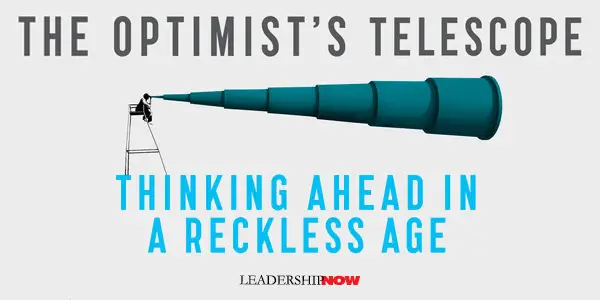
HOW DO YOU get people to think ahead? In a time characterized by wide-ranging change, we need to think through the consequences of what we have wrought. We need to think ahead. It is reckless not to. Since we can’t predict the future it makes it hard for us to think about the future. It should come as no surprise that our view of the the future is often misguided. In 1920, British economist Arthur Cecil Pigou described our often skewed view of the future as our “defective telescope.” In The Optimist’s Telescope, author Bina Venkataraman suggests that we need to cultivate a “radical strain of optimism” and a sense of collective agency that would motivate “more people to make choices today for the sake of the future, whether it’s how they vote, eat, use energy, or influence others.” An “optimist’s telescope” so to speak. Looking beyond the noise is key to thinking ahead. “Urgency and convenience are dictators of decisions large and small. We are frequently distracted from our future selves and the future of our society by what we need to accomplish now.” Our society is designed around quick wins because that’s what we want. “The conditions we have created in our culture, businesses, and communities work against foresight.” Rewards are given for the quick win. We need foresight. Foresight combines what we know with the humility to know that we don’t know it all and be ready for the possibilities. And that requires a little imagination. Venkataraman eloquently states, “We try too hard to know the exact future and do too little to be ready for its many possibilities.” Venkataraman offers countless examples of how individuals and organizations have defied instant gratification and instead taken the long view. When one investment firm saw a stock price fall they wisely avoided a knee-jerk reaction. “They avoided distractions of the moment by returning like a broken record to their original rationale for believing in the stock. You might call this a North Star tactic, calling on people in an organization to habitually look up from daily minutiae to reorient themselves to their ultimate destination.” At a Stanford Director’s College in 2016, Roger Dunbar, chair of the Silicon Valley Bank, told Venkataraman that “when he hears company executives or board members responding to short-term noise with outsize reactions, he likes to pretend he is lost. He’ll ask CEOs at board meetings, ‘What was our long-term strategy again?’ as if he has forgotten it. Sometimes, he says, company leaders suffer from being too smart—analyzing every piece of data that come their way—instead of asking simple but pivotal questions. It can help, in his view, to have a board member who is not afraid of sounding naïve or even a touch senile.” It helps too to look past typical metrics to see what is actually happening long-term. Dan Honig, a political scientist at the John Hopkins School of Advanced International Studies, believes that “metrics can be useful when an organization has a simple, concrete goal such as building a road. The trick is for the measure to be tightly linked to what the organization actually wants to accomplish. For the more complex undertakings of organizations, however, numeric targets are often far removed from actual goals and more likely to deceive. In those instances, Honig says, managers are better off using their judgment to evaluate progress. It’s a common mistake for organizations to attach simple metrics to nuanced goals such as educating children, reforming the justice system, or growing an innovative business.” It would be a bitter irony to remain entranced by myopic metrics, gearing ourselves up to hit immediate targets at a time when technology and our economy are evolving to privilege humans for being visionary, empathetic, nuanced, and strategic. In the future, the human edge is going to come from what we value and from our judgment, not from going head-to-head with machines to parse facts. On a personal level, we too can learn to measure ourselves by more meaningful metrics than what we have achieved in the moment. From her research, Venkataraman has extracted five key lessons to help us think ahead and stay the course: 1. Look Beyond Near-Term Targets “We can avoid being distracted by short-term noise and cultivate patience by measuring more than immediate results.” Instead of looking at snapshots, reflect on long-term goals. 2. Stoke the Imagination “We can boost our ability to envision the range of possibilities that lie ahead.” Allow time to imagine future risks and rewards and then visualizing how we can successfully navigate those futures. 3. Create Immediate Rewards for Future Goals “We can find ways to make what’s best for us over time pay off in the present” or “seek programs that offer immediate allure but are designed for our long-term interest.” In an example she shares about Toyota, they found a way to use the insights gained from long-term research on current production. “They found a way to create immediate rewards that made their sacrifices for the sake of future products seem worth it now to company leaders and investors.” 4. Direct Attention Away from Immediate Urges “We can reengineer cultural and environmental cues that condition us for urgency and instant gratification.” Avoid temptations. Where urgency rules, create systems that interrupt the momentum to create space to consider the decision. 5. Demand and Design Better Institutions “We can create practices, laws, and institutions that foster insight.” Look for solutions that encourage us to look ahead. Of course, institutions are made up of people, so we only need to look to ourselves first rather than trying to regulate foresight. Ultimately, Venkataraman believes we need to think like stewards or as she puts it, “keepers of shared heirlooms.” Heirlooms carry with them the “notion that future generations matter to the present generation, and that past generations will matter to the future.” Furthermore, “with an heirloom, each generation is both a steward and a user. When we pass on an heirloom, we don’t prescribe what each steward must do with it. Instead, we leave options open to the next generation.” It’s a good way to view our responsibility to think ahead. 
Posted by Michael McKinney at 05:30 AM
09.02.19

Artificial Persuasion: The Invisible Brand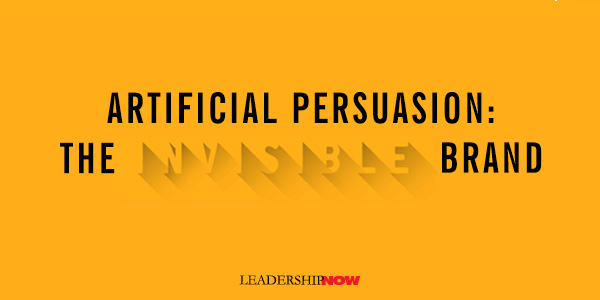
MASS MEDIA has been replaced by mass personalization through the rise of Artificial Intelligence. William Ammerman states in The Invisible Brand, “AI will play an increasingly important role in our lives in the years ahead as marketers turn vast amounts of computing power to the problem of influence people’s decisions.” Buried deep within the media we consume and the apps we use, unseen forces are working behind the scenes collecting data about us to pair with AI and digital advertising to influence everything we do. As a business, the challenge is how to best use this technology to promote ideas and products. As a consumer, the challenge is to understand how this technology is influencing us. Most of the time, it serves us well enhancing our lives and improving efficiency, and we welcome it. There are times when it feels like Big Brother is watching us. A better understanding of what is actually behind the technology will help us to ask better questions and respond in a measured and responsible manner. In a highly accessible way, Ammerman goes into great detail to explain how this technology is emerging and permanently altering the human-computer relationship. He identifies this emerging field as psychological technology, or simply psychotechnology. His focus is on marketing, but psychotechnology is working invisibly to reshape our behaviors in other areas of our lives. (Indeed, broadly speaking, everything we do is marketing.) Psychotechnology combines four areas of innovation: Personalization: Personalization is the norm in digital advertising. Machine learning connects all that data and allows marketers to tailor their messages just for you with your personality in mind. Persuasion: Marketers can use our innate human characteristics to influence our behaviors and thinking. Persuasion is not a new science, but today, it can be executed in new ways. “The science of persuasion is uncovering these unconscious reflexes that trigger specific behaviors.” Ammerman provides a fascinating look at how the science of persuasion is deployed behind the scenes in ways that influence our emotions and brain chemistry. Able to Learn: The amount and kind of information that is and can be gathered about our lives is astonishing. We don’t even think about it. Combined with AI, all this data gathering can be exploited through the power of machine learning. “Algorithms can learn by being fed data about what works and doesn’t work, and they can adapt in real-time to changing information.”  We can now have conversations with machines based on data about what we like, where we go, and who we know that is not unlike the conversations we would have with friends. Increasingly, people are creating emotional bonds with AI-powered machines. Our personal AI-powered tutor could help us to be continual lifelong learners—“a resource to help us learn the skills we need for our jobs, or even help us to identify the various flora and fauna we might spy on a mountain hike.” Ammerman raises questions regarding who owns our data, what is the government’s responsibility, should there be limits, and it’s use in political propaganda. For better or worse, the invisible brand is with us, and we have come to depend on it. “Behind all of this psychotechnology is an army of interests: corporations, governments, unions, politicians, religions, scientists, and universities, all vying for our hearts and minds. Through psychotechnology these brands operate invisibly, but collectively they are reshaping the market and the role of marketing.” Tim Berners-Lee remarked, “If you put a drop of love into Twitter, it seems to decay, but if you put in a drop of hatred, you feel it actually propagates much more strongly.” Perhaps we are hardwired to develop trust and connections slowly, being ever on the lookout for deceit and deception. A drop of love must be confirmed over and over across a long expanse of time to gain traction. We are slow to trust. Conversely, our instinct for survival has us on edge, always ready to respond aggressively to threats. A drop of hate triggers us more quickly, as we respond with less hesitation. This is an exploit the Invisible Brand can use against us by hacking our hate. To remain competitive, business must understand the forces shaping the marketplace. And consumers must educate themselves to the opportunities and dangers and develop the wisdom to think for themselves. Continue the discussion with these thought starters from William Ammerman: ▪ We’ve gone from delivering the same message to everyone at the same time through mass communications, to technology that can deliver different messages to every individual, on demand, through mass customization. 
Posted by Michael McKinney at 10:00 PM
09.01.19

First Look: Leadership Books for September 2019Here's a look at some of the best leadership books to be released in September 2019. Don't miss out on other great new and future releases. 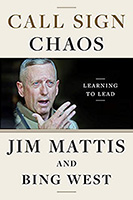 Call Sign Chaos: Learning to Lead by Jim Mattis and Bing West Call Sign Chaos: Learning to Lead by Jim Mattis and Bing West
Call Sign Chaos is the account of Jim Mattis’s storied career, from wide-ranging leadership roles in three wars to ultimately commanding a quarter of a million troops across the Middle East. Along the way, Mattis recounts his foundational experiences as a leader, extracting the lessons he has learned about the nature of warfighting and peacemaking, the importance of allies, and the strategic dilemmas—and short-sighted thinking—now facing our nation.
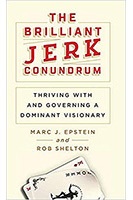 The Brilliant Jerk Conundrum: Thriving with and Governing a Dominant Visionary by Marc J. Epstein and Rob Shelton The Brilliant Jerk Conundrum: Thriving with and Governing a Dominant Visionary by Marc J. Epstein and Rob Shelton
With a strong leader at the helm, what can possibly go wrong? Betting on a dominant visionary is one of the biggest business gambles an investor, employee, or board member will ever make. If things go right, a visionary's wizardry changes entire industries and generates massive value for shareholders, employees, and society. But if things go wrong, millions (possibly billions) of dollars are lost--and sometimes people go to jail. The challenge for investors, employees, and board members is knowing the difference between an inspired visionary and an idealistic time bomb and if, when, and how to intervene.
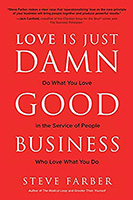 Love is Just Damn Good Business: Do What You Love in the Service of People Who Love What You Do by Steve Farber Love is Just Damn Good Business: Do What You Love in the Service of People Who Love What You Do by Steve Farber
It’s time to toss aside the touchy-feely notions of love in business and acknowledge the real power that it holds. Love is not only appropriate in the context of business, it’s the foundation of great leadership. To put it bluntly: love is just damn good business. It’s a refreshingly human way of doing business.
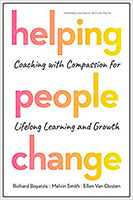 Helping People Change: Coaching with Compassion for Lifelong Learning and Growth by Richard Boyatzis, Melvin L. Smith and Ellen Van Oosten Helping People Change: Coaching with Compassion for Lifelong Learning and Growth by Richard Boyatzis, Melvin L. Smith and Ellen Van Oosten
Helping others is a good thing. Often, as a leader, manager, doctor, teacher, or coach, it's central to your job. But even the most well-intentioned efforts to help others can be undermined by a simple truth: We almost always focus on trying to "fix" people, correcting problems or filling the gaps between where they are and where we think they should be. Unfortunately, this doesn't work well, if at all, to inspire sustained learning or positive change. There's a better way.
 The Ride of a Lifetime: Lessons Learned from 15 Years as CEO of the Walt Disney Company by Robert Iger with Joel Lovell The Ride of a Lifetime: Lessons Learned from 15 Years as CEO of the Walt Disney Company by Robert Iger with Joel Lovell
This book is about the relentless curiosity that has driven Iger for forty-five years, since the day he started as the lowliest studio grunt at ABC. It’s also about thoughtfulness and respect, and a decency-over-dollars approach that has become the bedrock of every project and partnership Iger pursues, from a deep friendship with Steve Jobs in his final years to an abiding love of the Star Wars mythology.
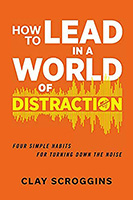 How to Lead in a World of Distraction: Four Simple Habits for Turning Down the Noise by Clay Scroggins How to Lead in a World of Distraction: Four Simple Habits for Turning Down the Noise by Clay Scroggins
While many leaders have learned to tune out distractions that keep them from being productive, they remain deaf to their inner desires and emotions. In How to Lead in a World of Distraction, Clay Scroggins teaches leaders four simple habits that create space for emotional evaluation and exploration. These helpful practices will empower leaders to replace the chaos of their busy days with emotional competence and awareness that leads to a calmer, more fulfilling life.
 Build your leadership library with these specials on over 39 titles. All titles are at least 40% off the list price and are available only in limited quantities. “If we encounter a man of rare intellect, we should ask him what books he reads.” — Ralph Waldo Emerson
Posted by Michael McKinney at 12:15 AM
|
BUILD YOUR KNOWLEDGE


How to Do Your Start-Up Right STRAIGHT TALK FOR START-UPS 
Grow Your Leadership Skills NEW AND UPCOMING LEADERSHIP BOOKS 
Leadership Minute BITE-SIZE CONCEPTS YOU CAN CHEW ON 
Classic Leadership Books BOOKS TO READ BEFORE YOU LEAD |
|